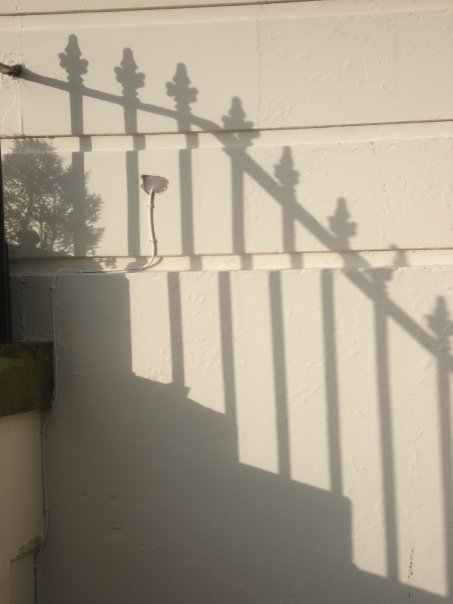Apr-2020
The Lost Railings of The Crescent
Walk along The Crescent and glance at the tops of the gardens walls and it won’t be long before you notice metal studs, a remanent of the original garden railings. In such a carefully preserved area you may wonder why were the iron railings removed?
The answer lies in wartime Britain. During the summer of 1941 the United States stopped exporting scrap metal to Britain. As a result the government declared that all unnecessary metal, including railings and gates, was to be removed, melted down and utilised for the war effort. Newspapers made patriotic appeals and there was even a touring ‘Railings for Scrap’ exhibition. Some seemingly outlandish remarks were made claiming that a garden gate could make fifty guns and the ironwork of a typical villa could equate to ten Bren Guns.
Cheltenham held its own railing exhibition, the central exhibit being the mangled remains of a German aircraft, ‘destroyed by converted railings’. The exhibition labelled the railings ‘ugly unnecessary’ and the mayor of the town even said that Cheltenham had ‘miles of railings that are not wanted and are an eyesore’. Mr F. Bullock of the Ministry of Supply, Iron and Steel Control claimed that Cheltenham had enough surplus railings ‘to build a destroyer’. Opposition to the mass cull of the railings was muted. A group of artists in London did protest against the removal of Georgian railings around Berkeley Square, it was, as Gavin Stamp wrote, ‘brave … while the Battle of Britain was being fought overhead’.
From Cornwall to the Shetlands, railings were torn down from churches, homes, schools and public buildings. At Filey the iron railings of The Crescent were removed early in the war and it is thought that around ninety tons or ironwork was removed. It was a highly visual campaign that was perhaps more useful in morale terms than in any actual contribution to the war effort. For although around one million tons of ironwork had been collected by 1944, it is now thought that as little as 26% of the ironwork was used by the war industries.
The remaining 74% is thought to have been stored in depots, quarries and railway sidings. In late 1944 complaints about a huge dump on a Hull dock prompted the local paper to print denials that the removals had been ‘unnecessary’. To admit that the campaign had been pointless would have been politically difficult for any government, so, it is alleged, that the, often ornate, railings and gates were thrown into landfill sites or dumped out at sea.
The dumping of the railings at sea was highlighted in a letter in the London Evening Standard in 1984, where Christopher Long wrote: “I believe that many hundreds of tons of scrap iron and ornamental railings were sent to the bottom in the Thames Estuary.” Long cited Canning Town dockers who told him that so much ironwork was dumped that ships using the estuary needed pilots as the vast amount of dumped iron affected ship’s compasses. On the 1987 Channel 4 television series, The Victorian House, the presenter Jonathan Meades furthered the claim stating:
‘The stuff was never melted down and was thrown into the Thames rather unceremoniously off Sheerness on the Isle of Sheppey. The stuff’s still there.’
Even more outlandish claims have been made that the railings made their way to Russia via the Arctic Convoys and were utilised on the eastern front, or that they were used as ballast on African bound merchant ships and they now adorn houses in West African port cities.
Clearly, a major element of Britain’s Victorian streetscapes was lost to the nation during the Second World War. However, given the vast amount of documentation and photographic evidence held in public archives, the resources to identity what was lost exists. Additionally, reinstalling the railings would be a relatively cheap, but highly visual, restoration. Indeed, successful campaigns to replace ironwork have taken place in Bath, Birmingham, Edinburgh, Harrogate, Manchester and London.
Since the 1970s the Bath Preservation Trust have driven a campaign that has resulted in virtually all of the iron railings being reinstated. Funding restorations and reinstatements has involved a number of bodies including Bath & North Somerset Council, the Bath Preservation Society, English Heritage, Heritage Lottery Fund, the UNESCO World Heritage Site Steering Group and various community groups. The conservation officer of Bath & North Somerset Council has overseen community driven reinstatements and in one project, the restoration of corroded railings at the Royal Crescent, there was archival research, surveys, paint analysis and even archeology. In 2001 the restoration of the entire missing ironwork of the Royal Victoria Park comprised of twenty-seven separate projects funded by a £1.86m grant from the Heritage Lottery Fund. As confidence, and recognition of the value of the projects to Bath’s streetscapes, grew, reinstatement of intricate light fittings that included glass blown lanterns and the instillation of micro florescent lamps.
Locally, Scarborough and Whitby offer grants for work proposed through the Scarborough or Whitby Town Scheme, the Conservation Area Improvement Scheme and the Whitby Architectural Features Scheme. Scarborough Borough Council’s listed building, and conservation area, guidance regarding railings is very supportive of the reinstatement of the features. The document is unequivocal in its support:
Architectural ironwork can make a significant contribution to the character of listed buildings and conservation areas. Streets such as The Esplanade, Scarborough and The Crescent, Filey, derive much of their character from their ironwork.
As part of its campaign to improve the historic built environment, Scarborough Borough Council wishes to encourage an historically accurate reinstatement of the railings. Old photographs, plans or fragments of railing at nearby properties are often a useful source of information. Modern off-the-peg ‘period’ ironwork is often poorly designed, flimsy and not suitable for historic buildings. The planning department can advise you on an appropriate design.
Clearly, Scarborough Council would support any campaign to reinstate the lost railings of Filey’s Crescent. Enough remnants remain to be able to gain both an idea of the designs used and the original colours used to paint the railings. Filey Town Council’s Crimlisk-Fisher Archive has a wonderful selection of period photographs that would offer further evidence of the spread and design of the missing ironwork. Those same resources could also be used to research a ‘design guide’ that could offer building owners a trusted resource that would illustrate original wall designs and heights, railing designs and even Victorian garden features. Thus the ground work would be laid for a potential restoration of The Crescent to its full Victorian splendour.


comment this post